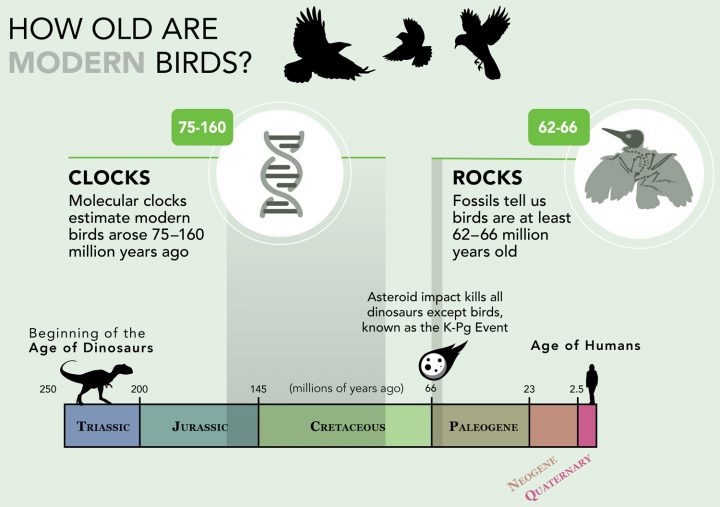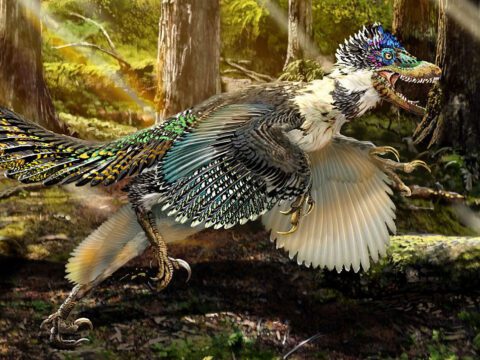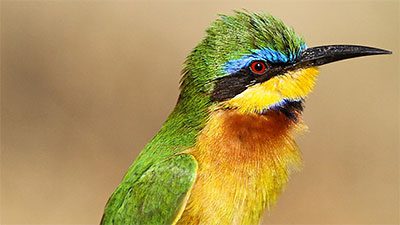That Asteroid That Killed the Dinosaurs? It May Have Sped Up Bird Evolution
By Pat Leonard
September 20, 2017
Human activities could trigger an altered pattern of evolution similar to what occurred 66 million years ago when a giant asteroid wiped out the dinosaurs, leaving birds as their only descendants. Cornell Ph.D. candidate Jacob Berv and Daniel Field, a Prize Fellow at the University of Bath, came to this conclusion after spending years studying the ancient genetic evolution of birds. They say knowing more about the effects of mass extinction on early bird life may reveal patterns for what lies ahead in the Anthropocene—the age dominated by humans.
“To understand the role of mass extinctions in shaping patterns of biodiversity, we’re studying how modern birds arose and diversified following the asteroid impact that marks the Cretaceous-Paleogene boundary, also called the K-Pg event,” said Berv.
In a new study published in Systematic Biology, Berv and Field consider whether the K-Pg mass extinction led to a temporary acceleration in the rate of genetic evolution among its avian survivors. The journal has made the article publicly available online through November 20, 2017.
The researchers jumped into this line of inquiry because of a thorny issue that has puzzled evolutionary biologists for a long time: the “rocks and clocks” debate. There’s often a huge discrepancy between age estimates obtained from the fossil record and estimates generated by molecular clocks, which use the rate at which DNA sequences change to estimate how long ago evolutionary divergences between species occurred.
“For example, if there are 10 DNA differences between the genomes of two species, and the estimated rate of change is one change per million years, then we can infer that those species shared a common ancestor about 10 million years ago,” Berv explains.

But there’s a problem. “The oldest fossils we know of that can be assigned to the modern bird group are scarcely older than the K-Pg boundary itself at around 66 million years,” Field says. “Molecular clocks tend to place the origination of modern birds many tens of millions of years earlier than that, well before the asteroid impact. Depending on the analysis, this discrepancy can be up to almost 100 million years—far too long to be explained by undiscovered fossils.”
Molecular clocks may overestimate ages in the avian family tree because they often assume a relatively steady rate of genetic evolution. However, if the K-Pg extinction caused avian molecular clocks to temporarily speed up, Berv and Field say this could explain at least some of the mismatch between between fossil age estimates and those of molecular clocks.
More Early Birds
To support their hypothesis, the authors examined an extensive avian family tree and noticed a clear link between body size and rates of genetic evolution: small birds evolve much faster than large ones. Using statistical modeling techniques to overcome the sparse avian fossil record, Berv and Field found that avian lineages surviving the mass extinction may have been about 80% smaller than their pre-K-Pg counterparts. Size reductions after mass extinctions may have occurred in many groups of organisms, a phenomenon dubbed the “Lilliput Effect” by paleontologists (in a nod to Gulliver’s Travels).
Berv and Field say the existing evidence is consistent with an avian Lilliput Effect across the K-Pg mass extinction.
Smaller birds also tend to have a faster metabolism (think hummingbird versus albatross). The hypothesis is that a speedier metabolism generates more mutations in the DNA (while the molecular clock assumes a steady rate of mutations to generate its estimates). The exact process is still not understood, but the pattern is there.
So, when the asteroid killed off the larger birds, the remaining, smaller birds had faster metabolisms and bred more quickly. This meant that on average, birds evolved more quickly than the assumptions made by molecular clock models.
“The bottom line is that, by speeding up avian genetic evolution, the K-Pg mass extinction may have temporarily altered the rate of the avian molecular clock”, says Field. “Similar processes may have influenced the evolution of many groups across this extinction event, like plants, mammals, and other forms of life. An interesting implication of this work is that the speedier rate of genetic evolution may have helped stimulate an explosion of avian diversity within only a short time of the K-Pg extinction event.” Says Berv, “Ultimately, The Lilliput Effect may have acted as nature’s hedge against avian extinction as new species proliferated to fill the gaps left by the mass extinction.”
The authors suggest that human activity may even be driving a similar Lilliput-like pattern in the modern world, as more and more large animals go extinct because of hunting and habitat destruction.
“We are currently eliminating the largest animals, just like the asteroid did. Many really big birds–the Dodo, elephant bird, and the moa, for example–have already gone extinct, likely because of human activity,” notes Berv. “Right now, the planet’s large animals are being decimated—the big cats, elephants, rhinos, and whales. We need to start thinking about conservation not just in terms of functional biodiversity loss, but about how our actions will affect the future of evolution itself.”
This research was supported by a National Science Foundation Graduate Research Fellowship and Doctoral Dissertation Improvement Grant to Berv (DGE-1650441, DEB-1700786), and a National Sciences and Engineering Council of Canada Graduate Scholarship to field. Berv was also supported by a Cornell Lab of Ornithology Athena Grant. Field is supported by a 50th Anniversary Prize Fellowship at the University of Bath.

All About Birds
is a free resource
Available for everyone,
funded by donors like you
American Kestrel by Blair Dudeck / Macaulay Library


